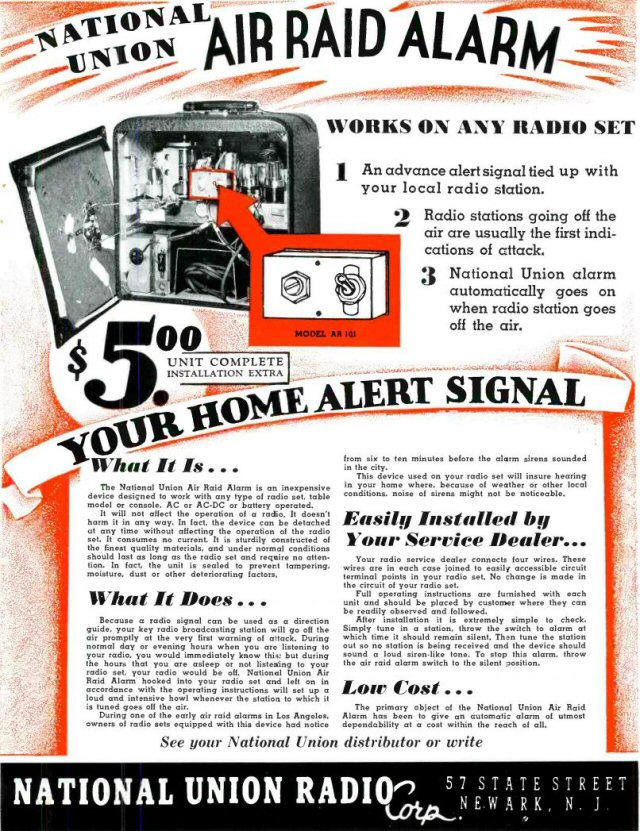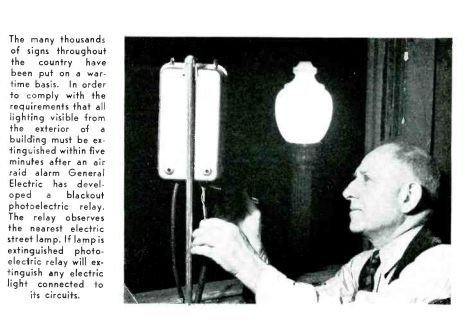Thursday, September 29, 2016
Still works
A direct ancestor of the various alarm apps for modern cellphones. This was advertised in a 1942 trade journal for radio repairmen. No new radios were being made for the duration, so radio shops had to find ways to make a little money while providing a real service.
 All radio stations in an area were instructed to stop transmitting when an air raid was known to be approaching so Jap planes couldn't use the signal for RDF. (This makes more sense than the later Conelrad approach.) If you were focusing on the radio you'd realize what happened; but if you were using the radio as background while doing household chores, you probably wouldn't notice the silence.
Hard to tell how the gadget worked. Possibly it rectified and filtered the audio output, and when output dropped to zero for a few seconds it added a feedback loop to the audio for a howl??? It looks too small to include a relay or a physical alarm sounder.
The ad mentions a fact that was common knowledge at the time:
"During one of the early air raid alarms in Los Angeles, owners of radio sets equipped with this device had notice from six to ten minutes before the sirens sounded."
Our postwar narrative has pushed those ACTUAL Jap attacks into the Memory Hole. They interfere with the official idea that the Japs were vulnerable peaceful Zen flower-like pacifists until we viciously and unprovokedly NUKED them for no reason in 1945.
At this late date the little gadget still performs the same service, alarming us to the real meaning of silence.
= = = = =
A similar gadget for another part of the electromagnetic spectrum:
All radio stations in an area were instructed to stop transmitting when an air raid was known to be approaching so Jap planes couldn't use the signal for RDF. (This makes more sense than the later Conelrad approach.) If you were focusing on the radio you'd realize what happened; but if you were using the radio as background while doing household chores, you probably wouldn't notice the silence.
Hard to tell how the gadget worked. Possibly it rectified and filtered the audio output, and when output dropped to zero for a few seconds it added a feedback loop to the audio for a howl??? It looks too small to include a relay or a physical alarm sounder.
The ad mentions a fact that was common knowledge at the time:
"During one of the early air raid alarms in Los Angeles, owners of radio sets equipped with this device had notice from six to ten minutes before the sirens sounded."
Our postwar narrative has pushed those ACTUAL Jap attacks into the Memory Hole. They interfere with the official idea that the Japs were vulnerable peaceful Zen flower-like pacifists until we viciously and unprovokedly NUKED them for no reason in 1945.
At this late date the little gadget still performs the same service, alarming us to the real meaning of silence.
= = = = =
A similar gadget for another part of the electromagnetic spectrum:
 A photocell aimed at the nearest streetlight. When the city cuts the streetlights for a blackout, you're supposed to turn off all externally visible lights. This supposedly did the job automatically. I doubt that it worked well; aiming would be difficult, and there are plenty of moving obstructions. Trucks, tree branches, pedestrians, moths. There are also moving lights that could turn your sign back on.
= = = = =
Sidenote: I looked through patents online to find a diagram for the first gadget. A couple of vaguely similar items, but nothing for that item. Probably wasn't patented. More interesting: Google's patent search has 2600 returns for 'air raid alarm', and 95% of them are recent Chinese patents. The few American patents are all before 1970. Who's ready for an air raid? China.
Later: Found a similar circuit. The key is the AVC voltage from the existing receiver. You'd connect the ground, B+, and AVC to the alarm gadget. A relay in series with a pot gets energized when AVC drops to zero. The relay turns on a buzzer, which is also across B+ and ground.
A photocell aimed at the nearest streetlight. When the city cuts the streetlights for a blackout, you're supposed to turn off all externally visible lights. This supposedly did the job automatically. I doubt that it worked well; aiming would be difficult, and there are plenty of moving obstructions. Trucks, tree branches, pedestrians, moths. There are also moving lights that could turn your sign back on.
= = = = =
Sidenote: I looked through patents online to find a diagram for the first gadget. A couple of vaguely similar items, but nothing for that item. Probably wasn't patented. More interesting: Google's patent search has 2600 returns for 'air raid alarm', and 95% of them are recent Chinese patents. The few American patents are all before 1970. Who's ready for an air raid? China.
Later: Found a similar circuit. The key is the AVC voltage from the existing receiver. You'd connect the ground, B+, and AVC to the alarm gadget. A relay in series with a pot gets energized when AVC drops to zero. The relay turns on a buzzer, which is also across B+ and ground.
 All radio stations in an area were instructed to stop transmitting when an air raid was known to be approaching so Jap planes couldn't use the signal for RDF. (This makes more sense than the later Conelrad approach.) If you were focusing on the radio you'd realize what happened; but if you were using the radio as background while doing household chores, you probably wouldn't notice the silence.
Hard to tell how the gadget worked. Possibly it rectified and filtered the audio output, and when output dropped to zero for a few seconds it added a feedback loop to the audio for a howl??? It looks too small to include a relay or a physical alarm sounder.
The ad mentions a fact that was common knowledge at the time:
"During one of the early air raid alarms in Los Angeles, owners of radio sets equipped with this device had notice from six to ten minutes before the sirens sounded."
Our postwar narrative has pushed those ACTUAL Jap attacks into the Memory Hole. They interfere with the official idea that the Japs were vulnerable peaceful Zen flower-like pacifists until we viciously and unprovokedly NUKED them for no reason in 1945.
At this late date the little gadget still performs the same service, alarming us to the real meaning of silence.
= = = = =
A similar gadget for another part of the electromagnetic spectrum:
All radio stations in an area were instructed to stop transmitting when an air raid was known to be approaching so Jap planes couldn't use the signal for RDF. (This makes more sense than the later Conelrad approach.) If you were focusing on the radio you'd realize what happened; but if you were using the radio as background while doing household chores, you probably wouldn't notice the silence.
Hard to tell how the gadget worked. Possibly it rectified and filtered the audio output, and when output dropped to zero for a few seconds it added a feedback loop to the audio for a howl??? It looks too small to include a relay or a physical alarm sounder.
The ad mentions a fact that was common knowledge at the time:
"During one of the early air raid alarms in Los Angeles, owners of radio sets equipped with this device had notice from six to ten minutes before the sirens sounded."
Our postwar narrative has pushed those ACTUAL Jap attacks into the Memory Hole. They interfere with the official idea that the Japs were vulnerable peaceful Zen flower-like pacifists until we viciously and unprovokedly NUKED them for no reason in 1945.
At this late date the little gadget still performs the same service, alarming us to the real meaning of silence.
= = = = =
A similar gadget for another part of the electromagnetic spectrum:
 A photocell aimed at the nearest streetlight. When the city cuts the streetlights for a blackout, you're supposed to turn off all externally visible lights. This supposedly did the job automatically. I doubt that it worked well; aiming would be difficult, and there are plenty of moving obstructions. Trucks, tree branches, pedestrians, moths. There are also moving lights that could turn your sign back on.
= = = = =
Sidenote: I looked through patents online to find a diagram for the first gadget. A couple of vaguely similar items, but nothing for that item. Probably wasn't patented. More interesting: Google's patent search has 2600 returns for 'air raid alarm', and 95% of them are recent Chinese patents. The few American patents are all before 1970. Who's ready for an air raid? China.
Later: Found a similar circuit. The key is the AVC voltage from the existing receiver. You'd connect the ground, B+, and AVC to the alarm gadget. A relay in series with a pot gets energized when AVC drops to zero. The relay turns on a buzzer, which is also across B+ and ground.
A photocell aimed at the nearest streetlight. When the city cuts the streetlights for a blackout, you're supposed to turn off all externally visible lights. This supposedly did the job automatically. I doubt that it worked well; aiming would be difficult, and there are plenty of moving obstructions. Trucks, tree branches, pedestrians, moths. There are also moving lights that could turn your sign back on.
= = = = =
Sidenote: I looked through patents online to find a diagram for the first gadget. A couple of vaguely similar items, but nothing for that item. Probably wasn't patented. More interesting: Google's patent search has 2600 returns for 'air raid alarm', and 95% of them are recent Chinese patents. The few American patents are all before 1970. Who's ready for an air raid? China.
Later: Found a similar circuit. The key is the AVC voltage from the existing receiver. You'd connect the ground, B+, and AVC to the alarm gadget. A relay in series with a pot gets energized when AVC drops to zero. The relay turns on a buzzer, which is also across B+ and ground.Labels: Patient things
